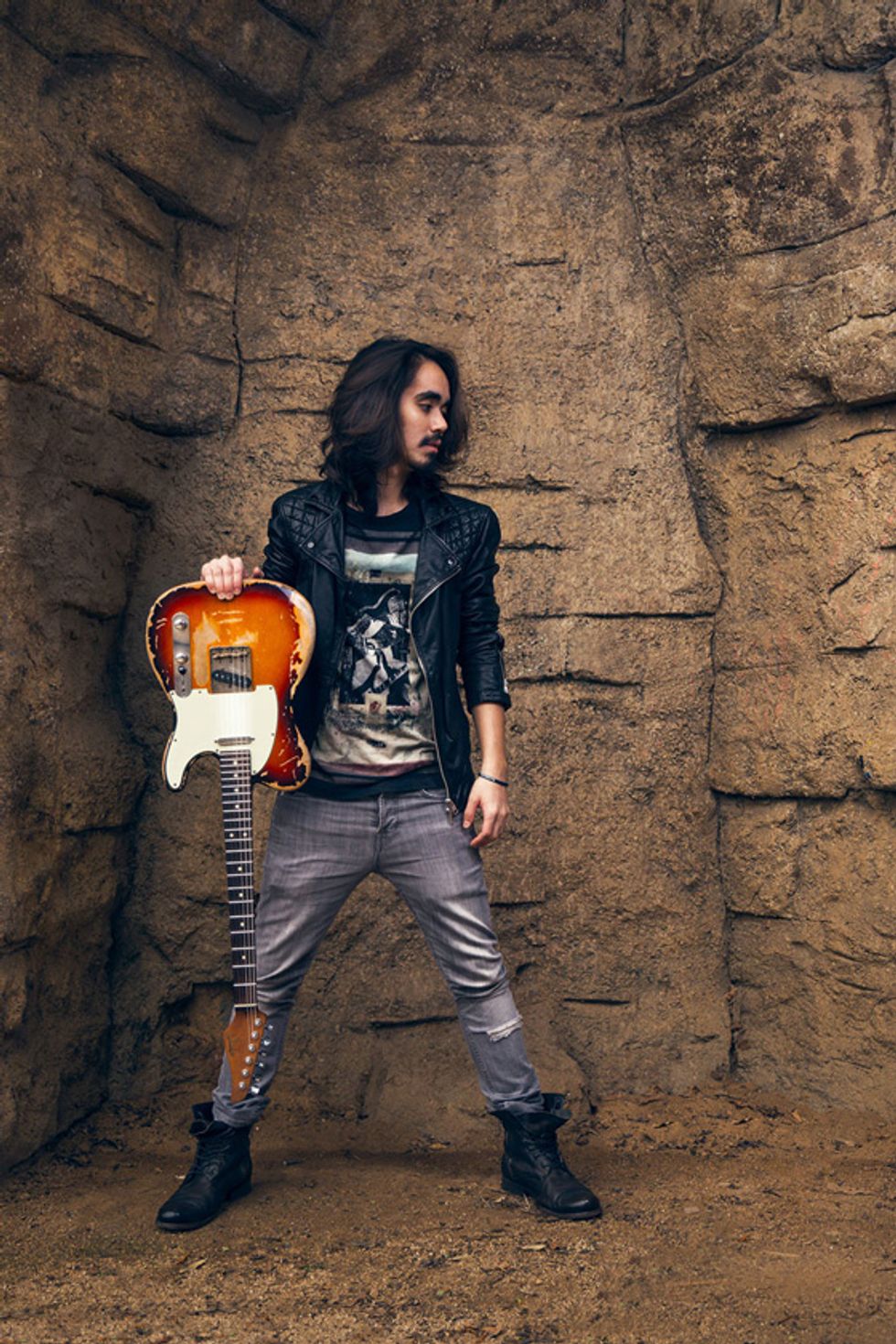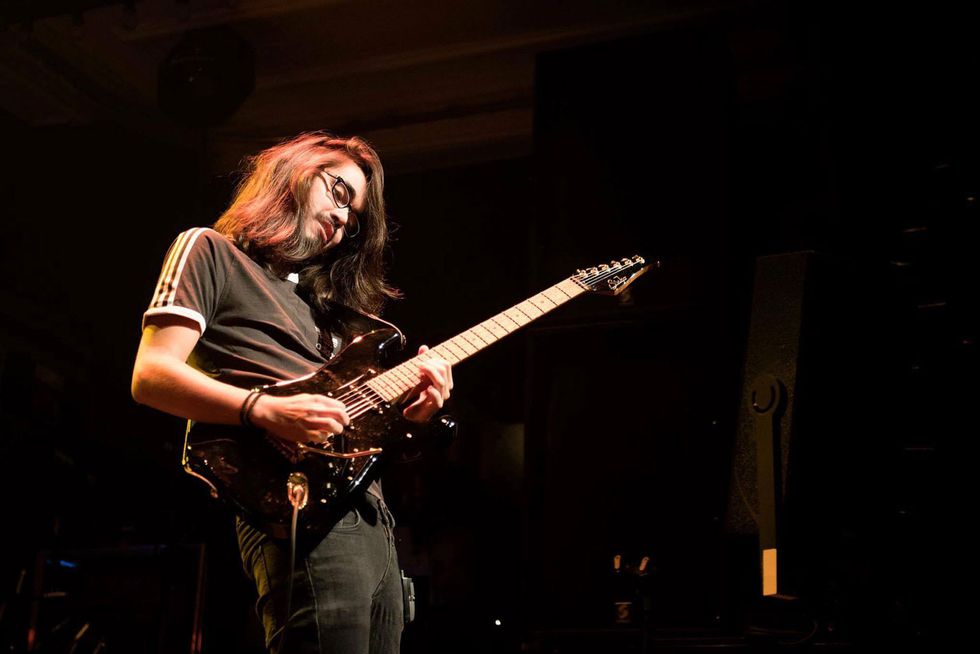The internet didn’t ruin music, but it sure changed the rules. It destroyed the old ways of making money. It made bad fashion choices from 40 years ago easy to find. But it also opened doors and leveled the playing field. Anyone with a cell phone and an Instagram account—or Facebook, or YouTube, or whatever—has more opportunities now. True, you need to hustle and you must be creative. And you probably need to be really good. But if you’re savvy and ready to work, the world is your oyster.
The guitar world’s undisputed new media master is Brazilian native/Los Angeles transplant Mateus Asato. Asato owns Instagram. Okay, he’s no Selena Gomez (Gomez has 128 million Instagram followers, which makes her the site’s most followed person). But at 380,000+ followers, he’s like the Selena Gomez of guitar. Asato built this following by putting up quality content, posting consistently—three times a week until his schedule made that impossible—experimenting, and studying his audience.
It doesn’t hurt that Asato is also a monster guitarist. He has a distinct sound that informs his note choices and feel, but within that framework he seems capable of almost anything. Heck, just check out his posts online—his rhythmic sense is metronome tight and his funk comping is fantastic.
Watch Mateus Asato’s guitar instrumental rendition of Crowded House’s “Don’t Dream It’s Over” and you’ll see why it has more than 1.6 million views.
He plays double-stops at warp speed, complex chord/melody arrangements, and difficult-to-execute contrapuntal voicings built on sophisticated jazz-influenced harmonies. His lead lines are super fast, yet tasteful and melodic. He goes back and forth between alternate picking, extended metal techniques, hybrid picking, and somewhat traditional fingerpicking—and he does that within the context of a song and sometimes within the context of a single line.
Asato is all over social media—and that’s how he came to our attention—but he also works as a sideman for A-list pop acts. He’s been touring with singer/songwriter Tori Kelly since 2015 and recently joined up with U.K. R&B singer Jessie J. “I’m rehearsing with Jesse J,” he said earlier this year over phone. “It’s a totally different gig—even though she has this R&B vibe—she’s way more pop and her songs have a lot of guitar. I like it. It’s very cool.”
We spoke with Asato about his background, practice habits, and how he developed his superior chops. He told us about his audition for Tori Kelly’s band and his time at Hollywood’s Musicians Institute. He also gives tried-and-true advice on how to record professional-sounding videos and build a following on social media.
When did you start playing?
I was about to turn 10 when I started playing the acoustic guitar. It took me a year to make the transition to electric because my mom was like, “Let’s see if you’re going to like the instrument for real. If you like it, then I will buy you an electric guitar.” I took private lessons in my hometown for a year and a half. It was informal and very chill.
My first gig was in church. When I turned 13, the guy who led worship at the church saw me and said, “If you want to join us, I would like to give you the chance. I like to support new talent.” I was totally down. In 2013, when I was 19, I decided to become a professional musician. I moved to Los Angeles and spent two years at Musicians Institute.
What did you study?
At MI I started learning theory and recording. I had lessons in Pro Tools, Logic—all that stuff. MI was very important to me because besides the knowledge, MI was also the platform for me to get the Tori Kelly gig. They were the bridge in between.
How did that happen?
The guitar director at MI, Stig Mathisen, got a call from Tori Kelly’s musical director. He said, “We need a guitar player for a Capitol Records artist. Can you name a few students?” Stig mentioned me and two or three other guys.

Brazilian-born Mateus Asato moved to Los Angeles when he was 19 to be a professional musician. He attended Musicians Institute and started building a following on social media before earning sideman gigs with Tori Kelly and Jessie J. Photo by Austin Cooper
Did they bring you down for an audition?
It was my first audition in my life, so I was very nervous. I had some classes at MI explaining how to behave at an audition, but every audition is different. With Tori, thankfully it was very chill. It was challenging because there was more than one musical director there. The musical director invited another musical director to join the audition. They were very picky. They were requesting a lot of creativity, like, “Imagine we have a song here and there is no guitar and we need an intro. What would you come up with?” They were asking for a lot of possibilities.
Was Tori there, too?
Thankfully she wasn’t there, because if she was, I would’ve probably felt way more nervous. But they were filming everything. They showed the videos to Tori and she had the last word. She said, “That’s the guy.” The way she branded me was, “I want the guy with the pink guitar.”
Talk about developing your sense of groove. What do you work on?
What helped me the most was playing with a real drummer, recording myself, and recording the rehearsals. This Tori Kelly gig was helpful because playing an R&B gig gives a whole different taste. My background in music was based on hard rock and progressive rock and the feel is very different. Rock players, we’re always either very tight or ahead of the beat. But I remember in the first rehearsals with Tori, they were always saying, “You’re rushing a little bit. Try to lay back and play a little behind the beat.” So that was a very nice way for me to develop my skills. Also, I spent a lot of time working on Tori Kelly’s guitar parts—recording myself so I could see the waves on Pro Tools or Logic, where I could sync to the metronome and could see if I was on the beat or ahead of it.
Do you use a click live?
We use a click. It’s always there and we have to be very on point. Pop gigs have a lot of hooks, so you’ve got to be very tight. It’s complicated sometimes but that’s how I normally work. When I’m just practicing guitar, I don’t practice much with the metronome, but whenever I’m working on a rhythm guitar section, that’s when I start using the click.
Asato loves hard rock and progressive rock. He honed his impressive chops by watching videos of Dream Theater,
Steve Vai, Joe Satriani, Steve Morse, and Paul Gilbert.
You seem to have mastered so many different picking techniques. Talk about how you developed those.
I grew up listening to a lot of Dream Theater, Steve Vai, Joe Satriani, Steve Morse—listening to those different guys was very important to me—and, also Paul Gilbert, I can’t forget him. He was very important to me developing my alternate picking. Listening and watching all those videos from all these guys. Later, when I moved to MI, I got into country music—once you are in America, you must get into it—a friend of mine introduced me to Brad Paisley’s music. I loved his touch. It’s so powerful and it sounds big. That’s when I started getting into hybrid picking.
Fingerstyle is interesting—when people ask me about fingerstyle technique they always mention Tommy Emmanuel, Andy McKee, and all these guys—but it was something natural. I thought, “What if I just use my hand instead of my pick?” It started very natural and was something I developed. But then, after listening to John Mayer, Andy McKee, and Tommy Emmanuel, I thought, “Wow, that’s the right way to do it.” After listening to those guys, I started learning and getting influenced by the way they play as well.
You have a unique way of hiding your pick when fingerpicking but making it reappear so you can pick.
At MI, I was in Carl Verheyen’s open counseling session [Verheyen is known for playing with Supertramp, plus lots of session work]. I remember watching him giving advice to another student. The other student put his pick on his lap and Carl said, “Imagine if you’re playing a concert live, where are you going to put your pick?” He gave that advice and that was pretty hard. I thought, “I’m going to try to find a way to hide the pick and play with my hands. That way, if I need to go back to the pick, it’s going to be okay.”
What’s your approach to chords and harmony?
The way I normally practice this is based on trial. Whenever I’m creating, I try as many possibilities as I can, in terms of harmony. Also, I listen to a lot of soundtracks—movie stuff—I listen and pay attention whenever I’m watching a movie or TV show, especially the orchestral stuff.
Most of the soundtracks I hear sound very melodic, but it’s not something that’s very outside, it’s not something jazzy, it’s not like insane. Whenever it gets to the romance or a different atmospheric place, I try to pay attention. Sometimes I even grab my guitar and transcribe a little bit. I have a lot of this stuff referenced when I’m creating.
Any good movies you recommend people play along to?
One of the last movies where the soundtrack really got me was Interstellar. It had some great lines, great melodies.
But I don’t try to go too outside in terms of melody. My first background was church, so there’s a lot of church influence on my musical tastes. All those soft melodies. Also hymns, it gives that classical concept—lots of key changes, all those things. My way of creating music is based on listening. The more I listen, the more I get inspired. I try a lot—it’s hard to explain in just words—I grab a random lead line and I start messing around with chords. Whenever I don’t think guitar is going to be enough, I grab a piano or keyboard and then I start messing around with the melody. To me, when I’m playing keys, it gives me a whole different perspective. Even though I don’t play piano well, at least I know where the notes are.
How did you build your fan base on social media?
Social media is interesting for me. I don’t know if you remember, but Instagram in the beginning was just for photos. I thought, “If Instagram starts allowing videos, they’re going to be great.” So, I was waiting for it. They started the videos and the first videos were only 15 seconds. I tried to create something that had a great taste and also a little bit of technique, but in 15 seconds. That was when all those licks and short melodies started to happen. It was a way for me to adapt to social media. I had to change my brain in terms of creativity. Normally when we’re writing music, we don’t put it in a box. It doesn't matter if a song is one minute or 13 minutes—it’s your music, it’s your creativity. But this 15-second Instagram video situation put me in a spot where I saw this as homework. I started making those and tried to see what people liked and what they didn’t like.

Various Suhr T-styles and S-styles (signature model to come)
Gretsch G6136T Players Edition White Falcon
Gretsch G6134TDC-LTD15 Penguin Midnight Sapphire Limited Edition
Gibson Les Paul Supreme
Amps
Bogner Duende 30-watt 2x12
Bogner Goldfinger
Suhr Bella
Suhr Badger 35
Fender Custom Shop Tone-Master
Effects
Strymon BigSky Reverberator
Eventide TimeFactor
Eventide H9
Bondi Effects Sick As Overdrive
Bondi Effects Del Mar Overdrive
Wampler Ego Compressor
Suhr Koji Comp
TC Electronic PolyTune 2 Noir
Boss TU-3 Chromatic Tuner
Neunaber Immerse Reverberator
Neunaber Expanse Series Slate
Wampler Tumnus
Ernie Ball volume pedal
Strings and Picks
Ernie Ball Skinny Top/Heavy Bottom (.010–.052) and Regular Slinky (.010–046) on Gretsches
Dunlop Tortex .88 mm
But the key to grow your social media is consistency. I got people’s attention because I was always uploading videos three times a week. Not nowadays. Now I get away from it because I have a different goal. Now I have to work more towards the real life: releasing an album, doing more shows, guitar clinics—that’s my goal now. But back then I was very focused on it. I thought, “Time to increase my following. Time to show people what I’m doing besides being in music school in Hollywood.” I organized my schedule where I could release three videos a week. That was something I targeted. I organized my schedule for social media.
Of course, even though I was consistent, I tried to change the day and the times I uploaded videos, because sometimes it worked at certain times, certain hours, and sometimes it didn’t. I tried to explore social media, especially Instagram. I explored that a lot.
What’s the sweet spot of Instagram? When is the best time to post a video?
It depends. That’s an interesting thing because there are a lot of details behind it. But I know, for example, if the video I post is a cover of a pop song, a catchy melody, I know Sunday night is a great pick. Sunday can be very boring. It’s the day before Monday and everybody is waiting for Sunday to end. What do you normally do on a Sunday night between 9 and 10 p.m.? You’re either with your phone or watching TV. So, to me, Sunday is a great day if I want to show something smooth or chill. If I want to play more heavy stuff, more serious technique stuff, probably the beginning of the week is best—like Monday or Wednesday—where people are going to be like, “Wow, this guy is working!” It depends on the type of guitar playing I want to show and the mood of the day. That’s how I organize it.
Do you record your videos with a camera and computer or right on your phone?
Most of my videos I do with the camera. I’ve been using the Canon 6D. I record it using the camera and at the same time my computer is connected in Pro Tools or Logic and I record the audio as well. I grab the piece that was recorded and I edit in Pro Tools or Logic first and then I go to a video editor. I use Final Cut. I edit and then I mix the natural camera’s audio with the Pro Tools audio—I use my Apogee Duet to do that. I try to mix both volumes and then I release it on Instagram.
Do you do the same thing for YouTube?
With YouTube, it’s the same thing and whenever the video is longer than a minute, that’s even better. I can use Instagram as a platform to share and say, “If you want to see the whole thing, go to my YouTube Channel.” That’s another way to promote different channels and situations where they just allow a one-minute video. I try to make it within one minute, but sometimes—creativity, never put music in a box—sometimes it’s longer. But if you want to see the extended version, go to my YouTube channel.
Do have an album coming out?
That was my plan for the second half of the year. I did an Asia promotional tour. Japan and South Korea are especially supportive of guitar. My plan was, after the Asian tour I was going to return to Los Angeles and finish this record. But now I’ve got a gig with Jesse J. She is a different pop artist. She’s great—it’s great music—and money-wise it was a very convincing proposal, so I decided to do this gig until December. My plan now is to spend January and February working to finish this record and then release it by late March or mid-April.
A lot of people will be eager to hear it.
Yeah. I think this Instagram project was great. Of course, I’m going to keep making those videos because it’s also a way to increase my following. But I think it’s about time to have something besides the screen, and I definitely want to move forward to a different area. Now my main focus, besides this Jessie J gig, is to release a record. I really want to.
Watch Mateus Asato in action with Tori Kelly as he opens her song “Beautiful Things” with a melodic, almost 2-minute solo.













![Rig Rundown: Russian Circles’ Mike Sullivan [2025]](https://www.premierguitar.com/media-library/youtube.jpg?id=62303631&width=1245&height=700&quality=70&coordinates=0%2C0%2C0%2C0)












![Rig Rundown: AFI [2025]](https://www.premierguitar.com/media-library/youtube.jpg?id=62064741&width=1245&height=700&quality=70&coordinates=0%2C0%2C0%2C0)




















 Zach loves his Sovtek Mig 60 head, which he plays through a cab he built himself at a pipe-organ shop in Denver. Every glue joint is lined with thin leather for maximum air tightness, and it’s stocked with Celestion G12M Greenback speakers.
Zach loves his Sovtek Mig 60 head, which he plays through a cab he built himself at a pipe-organ shop in Denver. Every glue joint is lined with thin leather for maximum air tightness, and it’s stocked with Celestion G12M Greenback speakers.











